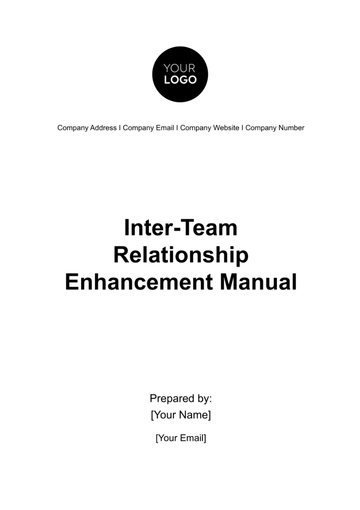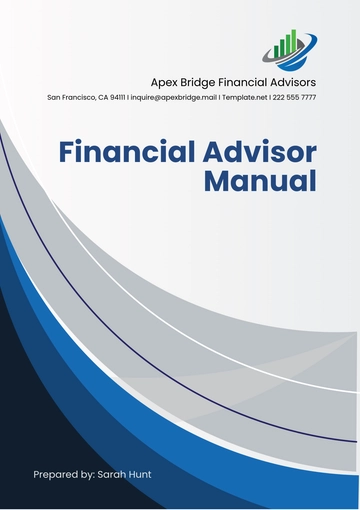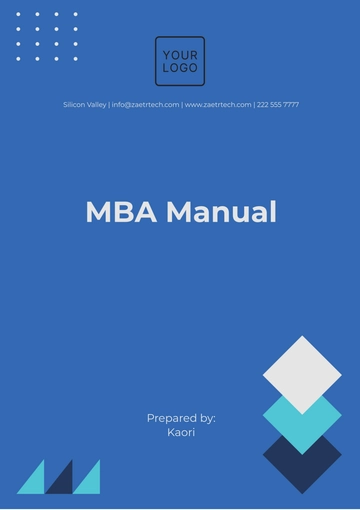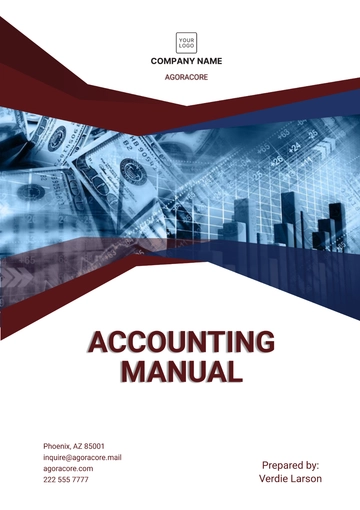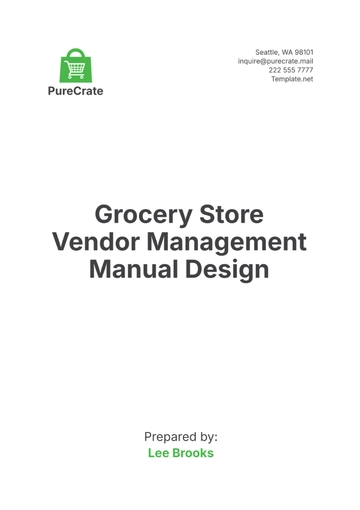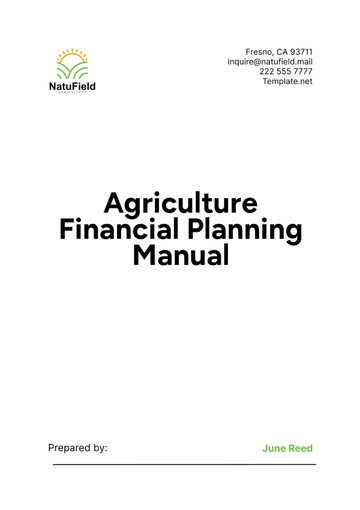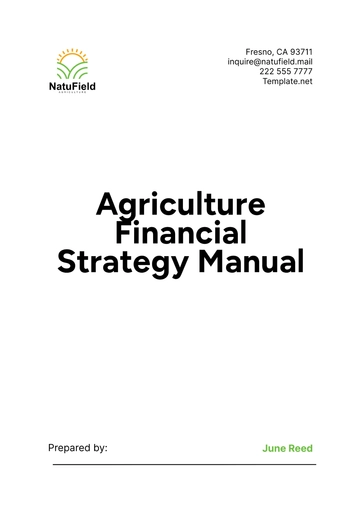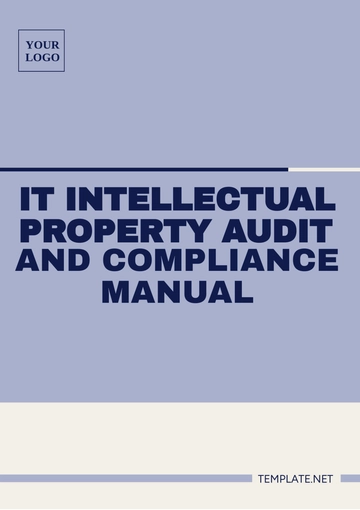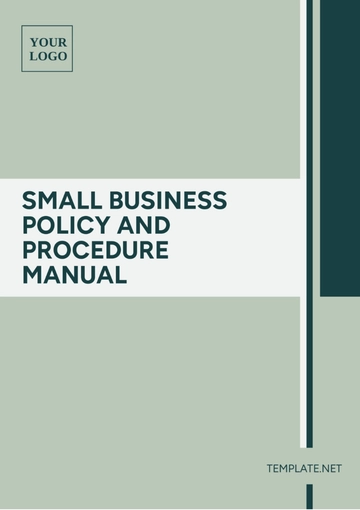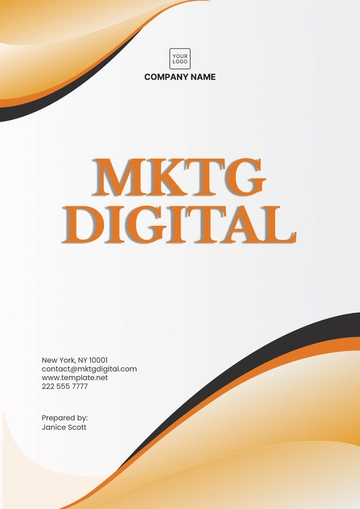Free Agriculture Financial Planning Manual
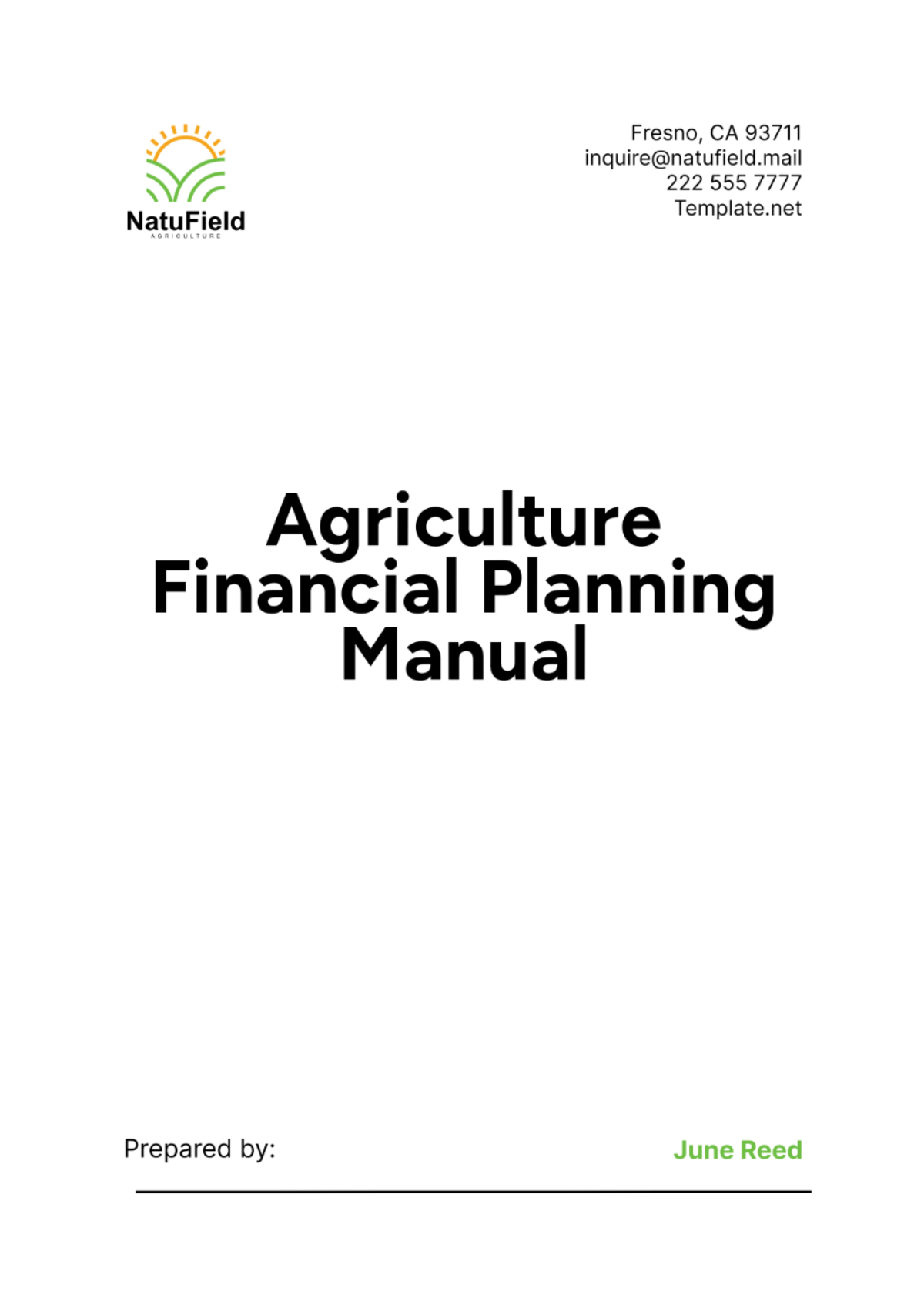
1. Introduction
1.1 Purpose
This manual is created to establish a comprehensive approach to financial planning within the agricultural sector for [Your Company Name]. It serves as a definitive guide to implementing effective financial strategies that align with our business goals. By adhering to the principles and practices outlined in this manual, we aim to enhance our financial decision-making processes, ensuring that all financial activities contribute to the overall success and sustainability of our agricultural operations.
1.2 Scope
The manual covers key aspects of budget management, cash flow forecasting, risk management, and investment planning. It provides detailed procedures for creating and maintaining budgets, accurately forecasting cash flows, and identifying and mitigating financial risks specific to the agricultural sector. Additionally, it includes comprehensive guidelines for making strategic investments and allocating capital efficiently to optimize returns. This manual is designed to be a practical tool that supports financial managers and decision-makers in their daily tasks.
1.3 Objectives
Our primary objective is to ensure financial stability and foster growth through effective financial planning and management. This involves developing robust budgeting processes that reflect realistic projections and operational needs. We aim to maintain a healthy cash flow to support our ongoing operations and future investments. By implementing sound risk management strategies, we seek to protect our financial interests from market volatility and unforeseen challenges. Ultimately, our goal is to create a financially resilient organization that can thrive in the competitive agricultural landscape.
2. Budgeting
Effective budgeting is crucial for [Your Company Name] to ensure efficient resource allocation, financial preparedness, and strategic decision-making. This section outlines the importance of budgeting, detailed steps for drafting an effective budget, and the review and approval process, providing a structured approach to achieving financial stability and growth.
2.1 Importance of Budgeting
Key Point | Details |
|---|---|
Efficient Resource Allocation | Budgeting ensures that resources are allocated effectively to meet operational and strategic goals. |
Financial Preparedness | By anticipating future financial needs, budgeting helps in planning for expenditures and investments. |
Control and Monitoring | Budgeting provides a framework for monitoring financial performance and controlling costs. |
Decision Support | Detailed budgets support informed decision-making and strategic planning. |
Risk Management | Budgeting helps in identifying potential financial risks and preparing mitigation strategies. |
2.2 Steps for Drafting a Budget
Below are the steps to draft an effective budget:
Step | Description | Action Items |
|---|---|---|
Assess Current Financial Status | Evaluate the current financial position, including assets, liabilities, income, and expenses. | Review financial statements |
Conduct a financial health check | ||
Identify and Categorize Expenses | Determine all expenses and categorize them into fixed, variable, and capital expenditures. | List all expenses |
Categorize expenses accurately | ||
Allocate Funds for Operational Costs | Distribute funds to cover daily operational costs, ensuring all essential functions are adequately financed. | Allocate funds to each department |
Prioritize essential operations | ||
Set Aside a Contingency Fund | Establish a reserve to cover unexpected costs or emergencies, ensuring financial stability. | Calculate an appropriate contingency amount |
Ensure the fund is easily accessible | ||
Review and Adjust the Budget Periodically | Regularly evaluate the budget against actual performance and make necessary adjustments. | Schedule periodic reviews |
Adjust allocations based on performance data |
2.3 Budget Review and Approval Process
Stage | Description | Participants | Action Items |
|---|---|---|---|
Initial Draft Preparation | Create the initial budget draft based on assessed needs and financial goals. | Finance Team | Compile financial data |
Draft budget document | |||
Internal Review | Conduct an internal review to verify accuracy and ensure alignment with strategic objectives. | Department Heads, Finance Team | Cross-check figures |
Align budget with departmental needs | |||
Management Review | Senior management reviews the budget for strategic alignment and feasibility. | Senior Management | Evaluate strategic fit |
Ensure feasibility of financial allocations | |||
Approval | The finalized budget is presented for approval by the board or executive committee. | Board of Directors, Executive Committee | Present final budget |
Obtain formal approval | |||
Implementation and Monitoring | Implement the approved budget and monitor its execution against actual performance. | All Departments | Allocate funds as per budget |
Track performance and report variances |
3. Financial Forecasting
Gain insights into future financial conditions with Section 3 of [Your Company Name]'s manual. Explore methods like trend analysis and econometric models to forecast accurately and make informed financial decisions.
3.1 Importance of Forecasting
Key Point | Details |
|---|---|
Informed Decision-Making | Financial forecasting provides insights into future financial conditions, enabling informed and strategic decision-making. |
Resource Allocation | Forecasting helps in planning resource allocation to ensure optimal use and avoid potential shortages. |
Risk Management | By anticipating financial trends, forecasting aids in identifying and mitigating potential risks. |
Strategic Planning | It supports long-term strategic planning by projecting future financial performance and aligning it with business goals. |
Financial Stability | Regular forecasting ensures the company remains financially stable by preparing for future financial requirements. |
3.2 Methods of Forecasting
Various methods like trend analysis, econometric models, and expert judgment can be utilized for accurate forecasting.
Method | Description | Advantages | Disadvantages |
|---|---|---|---|
Trend Analysis | Analyzing historical financial data to identify patterns and project future figures. | Simple to implement, uses existing data. | May not account for sudden market changes. |
Econometric Models | Using statistical methods and economic theories to forecast future financial outcomes. | Highly accurate, considers multiple variables. | Requires advanced statistical knowledge and data. |
Expert Judgment | Leveraging the knowledge and experience of industry experts to make financial predictions. | Benefits from expert insights and intuition. | Subjective and may be biased. |
3.3 Step-by-Step Instruction for Trend Analysis
Step | Description | Action Items | Examples |
|---|---|---|---|
Gather Historical Financial Data | Collect past financial data, including revenue, expenses, profits, and other relevant metrics. | Collect financial statements, organize data by time period. | Gather revenue data for the past five years, compile quarterly expense reports. |
Identify Trends and Patterns in the Data | Analyze the collected data to identify consistent trends and patterns over time. | Use graphical tools to visualize trends, identify recurring patterns. | Create line graphs of annual profits, detect seasonal expense patterns. |
Project Future Financial Figures Based on Identified Trends | Use the identified trends to forecast future financial performance. | Apply trend lines to data, calculate projected figures. | Use past revenue growth rates to project next year's income, estimate future expenses based on historical increases. |
Validate the Forecast with Current Market Conditions | Compare the forecasted figures with current market conditions to ensure accuracy. | Research current market trends, adjust forecast based on market analysis. | Adjust revenue projections based on current commodity prices, revise expense forecasts in light of recent supply chain disruptions. |
Adjust Projections as Necessary | Revise the forecasted figures to reflect any changes or new information. | Update projections regularly, incorporate new data and insights. | Revisit forecasts quarterly, adjust for unexpected events like droughts or market shifts. |
4. Cash Flow Management
Ensure liquidity and financial health with Section 4 of [Your Company Name]'s manual. Learn effective strategies to optimize cash inflow, control outflow, and monitor cash flow for proactive management.
4.1 Understanding Cash Flow
Key Point | Details |
|---|---|
Liquidity Maintenance | Managing cash flow is crucial to maintaining liquidity and ensuring the business can meet its financial obligations. |
Operational Continuity | Effective cash flow management ensures that there are sufficient funds to cover day-to-day operational expenses. |
Financial Health | Positive cash flow is an indicator of a company's financial health and its ability to invest in growth opportunities. |
Risk Mitigation | Proper cash flow management helps mitigate risks associated with cash shortages and financial instability. |
Decision-Making Support | Understanding cash flow provides a foundation for making informed financial decisions and strategic planning. |
4.2 Cash Flow Strategies
Strategy | Description | Advantages | Disadvantages |
|---|---|---|---|
Optimize Cash Inflow | Implement measures to accelerate cash receipts and enhance revenue collection. | Improves liquidity, reduces receivable days. | May strain customer relationships if not managed carefully. |
Control Cash Outflow | Manage expenses and delay payments where possible without affecting operations. | Enhances cash reserves, reduces immediate financial strain. | May impact supplier relationships if payment delays are excessive. |
Maintain Cash Reserves | Keep a portion of cash as a reserve to handle unexpected expenses and emergencies. | Provides a financial buffer, enhances financial stability. | Idle cash may reduce potential investment returns. |
Utilize Credit Facilities | Use credit lines and loans to manage short-term cash flow needs. | Provides immediate liquidity, supports cash flow management. | Increases debt obligations, may incur interest costs. |
Forecast Cash Flow | Regularly forecast cash flow to anticipate future needs and plan accordingly. | Improves planning, reduces uncertainty. | Requires accurate data and regular updates. |
4.3 Monitoring Cash Flow
Step | Description | Action Items | Examples |
|---|---|---|---|
Track Cash Inflows and Outflows | Record all cash transactions, including income and expenses. | Maintain detailed cash flow records, categorize transactions. | Use accounting software to log daily sales and expenses, categorize transactions by type. |
Analyze Cash Flow Statements | Review cash flow statements to understand the sources and uses of cash. | Identify trends, assess cash flow patterns. | Examine monthly cash flow statements to identify periods of surplus or deficit. |
Identify Cash Flow Issues | Detect any discrepancies or potential problems in cash flow early. | Monitor for unusual fluctuations, flag potential issues. | Spot a sudden increase in expenses, notice a delay in customer payments. |
Take Corrective Actions | Implement measures to address identified cash flow issues. | Adjust cash flow strategies, manage expenses. | Negotiate extended payment terms with suppliers, accelerate collection efforts. |
Regular Review and Adjustment | Periodically review and adjust cash flow management practices. | Schedule regular reviews, update cash flow strategies. | Conduct monthly cash flow reviews, revise projections based on new data. |
5. Financial Risk Assessment and Mitigation
Navigate financial uncertainties with Section 5 of [Your Company Name]'s manual. Discover how to identify, assess, and mitigate risks using qualitative and quantitative methods to safeguard financial stability.
5.1 Identifying Financial Risks
Key Point | Details |
|---|---|
Risk Identification | Identify potential financial risks to the business, including market volatility, credit risks, and operational disruptions. |
Early Preparation | Early identification allows for proactive measures to mitigate risks and minimize their impact on financial stability. |
Comprehensive Approach | Assess risks across all financial aspects, from investments to cash flow management, to ensure comprehensive risk management. |
Scenario Planning | Anticipate various scenarios to prepare for unexpected financial challenges and maintain resilience. |
Continuous Monitoring | Regularly review and update risk assessments to adapt to evolving market conditions and internal changes. |
5.2 Risk Assessment Methods
Method | Description | Advantages | Disadvantages |
|---|---|---|---|
Qualitative Analysis | Evaluates risks based on subjective judgment and expert opinions. | Provides insights into non-measurable risks, quick to implement. | Subject to bias, lacks quantitative precision. |
Quantitative Analysis | Uses statistical models and numerical data to quantify risks and probabilities. | Offers precise risk measurements, supports data-driven decisions. | Requires extensive data and expertise, may overlook qualitative aspects. |
Scenario Analysis | Examines potential outcomes of different scenarios to assess risk impact. | Helps in understanding multiple risk scenarios, prepares for uncertainties. | Relies on assumptions, may not cover all possible scenarios. |
5.3 Mitigation Strategies
Strategy | Description | Advantages | Disadvantages |
|---|---|---|---|
Diversification | Spread investments across different assets and markets to reduce overall risk. | Minimizes reliance on specific sectors, enhances portfolio resilience. | Increases complexity in portfolio management, diversification may not eliminate all risks. |
Insurance Coverage | Purchase insurance policies to protect against specific financial risks, such as property damage or liability. | Provides financial protection against unforeseen events, mitigates financial losses. | Premium costs can be expensive, coverage limitations may apply. |
Risk Avoidance | Avoid engaging in activities or investments with high potential risks. | Prevents exposure to specific risks, maintains financial stability. | Limits potential opportunities for growth or profitability. |
Risk Transfer | Shifts risks to other parties through contracts, agreements, or hedging strategies. | Reduces direct exposure to risks, shares financial burdens. | Transfer costs and complexities, reliance on external parties. |
Contingency Planning | Develops contingency plans to respond to unexpected events and minimize their impact. | Enhances preparedness, ensures business continuity. | Requires resources and time to develop effective plans, may not cover all possible scenarios. |
6. Investment Planning and Capital Allocation
Maximize returns and strategic growth with Section 6 of [Your Company Name]'s manual. Explore criteria for selecting investments and a structured process for allocating capital to enhance profitability and operational efficiency.
6.1 Importance of Investment Planning
Key Point | Details |
|---|---|
Resource Optimization | Effective investment planning optimizes resource allocation, ensuring funds are used efficiently. |
Enhanced Returns | It aims to enhance returns on investment by strategically allocating capital to profitable ventures. |
Risk Management | Proper planning helps in managing investment risks and balancing risk-return trade-offs. |
Long-Term Growth | Supports long-term business growth by funding strategic initiatives and expansion projects. |
Financial Stability | Contributes to financial stability by diversifying income sources and reducing dependency on a single revenue stream. |
6.2 Criteria for Investment Selection
Criteria | Description | Examples |
|---|---|---|
Risk | Evaluate the level of risk associated with each investment opportunity. | Consider risk tolerance, assess market volatility. |
Return | Analyze potential returns and profitability of investments. | Calculate expected ROI, compare historical performance. |
Alignment with Business Objectives | Ensure investments align with strategic goals and business priorities. | Support expansion plans, enhance product development. |
Liquidity | Assess the liquidity of investments to meet short-term financial needs. | Evaluate ease of selling assets, consider cash flow requirements. |
Time Horizon | Consider the investment time frame and its alignment with business timelines. | Determine short-term vs. long-term investment needs, plan for future liquidity needs. |
6.3 Capital Allocation Process
Step | Description | Action Items |
|---|---|---|
Assess Financial Needs | Determine the amount of capital required for various business activities. | Conduct financial analysis, assess funding requirements for projects. |
Prioritize Investment Opportunities | Rank investment opportunities based on predefined criteria and strategic priorities. | Develop scoring models, prioritize projects aligned with business goals. |
Allocate Capital | Allocate funds to selected investments and projects based on prioritization. | Set investment budgets, allocate resources efficiently. |
Monitor and Evaluate | Continuously monitor investment performance and reassess capital allocation as needed. | Implement performance metrics, conduct regular reviews of investment portfolios. |
Adjust Allocation as Necessary | Make adjustments to capital allocation based on changing business needs and market conditions. | Review investment strategy, reallocate funds to optimize returns. |
6.4 Capital Allocation Table
Investment Category | Allocated Capital | ROI | Strategic Importance |
|---|---|---|---|
Agricultural Equipment | $500,000 | 8% | Enhances operational efficiency, reduces labor costs. Supports mechanization and modernization efforts. |
Land Acquisition | $1,000,000 | 12% | Expands farming capacity, secures future growth opportunities. Increases land asset value and agricultural production potential. |
Crop Research | $300,000 | 10% | Drives innovation in crop yield and quality. Improves resilience against pests and environmental factors. Supports sustainable farming practices. |
Infrastructure Development | $700,000 | 9% | Improves farm infrastructure, enhances logistics and storage capabilities. Supports efficient distribution and market access. |
Marketing and Distribution | $400,000 | 7% | Expands market reach, increases brand visibility. Supports sales growth and customer acquisition strategies. |
Insights:
Agricultural Equipment: Investment in agricultural equipment is crucial for [Your Company Name] to streamline operations and reduce dependency on manual labor. The 8% ROI reflects cost savings in labor and increased productivity. Modern equipment enhances efficiency in planting, harvesting, and processing, contributing to overall operational efficiency and profitability.
Land Acquisition: Allocating $1,000,000 towards land acquisition supports [Your Company Name]'s strategic growth initiatives. The 12% ROI is driven by increased agricultural production capacity and appreciation in land value. Acquiring additional land secures future expansion opportunities and mitigates risks associated with land scarcity and rising prices.
Crop Research: Investment in crop research at $300,000 is essential for [Your Company Name] to innovate and improve crop yields. The 10% ROI reflects advancements in seed technology, pest resistance, and climate adaptation. Research initiatives enhance sustainability practices and resilience against environmental challenges, ensuring long-term profitability and market competitiveness.
Infrastructure Development: $700,000 allocated to infrastructure development enhances [Your Company Name]'s logistical capabilities and storage capacities. The 9% ROI is driven by improved efficiency in distribution and market access. Upgraded infrastructure supports timely delivery to markets, reduces wastage, and strengthens relationships with buyers, contributing to sustainable revenue growth.
Marketing and Distribution: Allocating $400,000 towards marketing and distribution initiatives expands [Your Company Name]'s market reach and brand visibility. The 7% ROI reflects increased sales volume and customer acquisition. Strategic marketing efforts enhance brand reputation and customer loyalty, driving revenue growth and market share expansion.
These insights into capital allocation demonstrate [Your Company Name]'s strategic focus on enhancing operational efficiency, expanding agricultural production capacity, and driving innovation and market penetration through targeted investments. Each investment category plays a critical role in achieving long-term growth and profitability objectives.
7. Conclusion
Implementing the strategies and guidelines detailed in this manual positions [Your Company Name] to achieve sustained financial stability and operational excellence within the agricultural sector. By rigorously adhering to sound financial planning practices, including budgeting, cash flow management, risk assessment, and investment planning, the company can optimize resource allocation and mitigate financial risks effectively. These efforts are crucial for maintaining liquidity, enhancing profitability, and fostering resilience against market fluctuations and operational challenges. Ultimately, through disciplined financial management and strategic decision-making, [Your Company Name] can navigate complexities, capitalize on growth opportunities, and ensure sustainable success in agricultural operations.
- 100% Customizable, free editor
- Access 1 Million+ Templates, photo’s & graphics
- Download or share as a template
- Click and replace photos, graphics, text, backgrounds
- Resize, crop, AI write & more
- Access advanced editor
Experience streamlined financial planning with the Agriculture Financial Planning Manual Template from Template.net. This fully customizable and editable template simplifies budgeting and forecasting for agricultural businesses. Easy to format and tailor-made for your needs, it’s editable in our AI Editor Tool. Don’t miss the opportunity to enhance your financial planning efficiency—try it today and see the difference.
